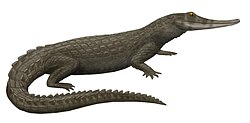Isisfordia
| Isisfordia | |
|---|---|

| |
| Restoration of I. duncani | |
| Scientific classification | |
| Domain: | Eukaryota |
| Kingdom: | Animalia |
| Phylum: | Chordata |
| Class: | Reptilia |
| Clade: | Archosauria |
| Clade: | Pseudosuchia |
| Clade: | Crocodylomorpha |
| Clade: | Crocodyliformes |
| Clade: | Neosuchia |
| Genus: | †Isisfordia Salisbury et al. 2006 |
| Type species | |
| †Isisfordia duncani Salisbury et al. 2006
| |
| Other species | |
| |
| Synonyms | |
| |
Isisfordia is an extinct genus of crocodyliform closely related to crocodilians that lived in Australia during the Middle Cretaceous (Albian–Cenomanian).
Description
[edit]The type species, I. duncani. (named after the discoverer; former Deputy Mayor of Isisford, Ian Duncan) was discovered in the Winton Formation in Isisford, Queensland, Australia in the mid-1990s.[2][3] Most of the animal was discovered, with the exception of the front portion of the skull. On a later expedition to the location, paleontologists discovered a complete skull which differed from the original specimen in size only.[3] A second species I. molnari was named in 2019 from a braincase found in the Griman Creek Formation near Lightning Ridge, and the nominal species Crocodylus (Bottosaurus) selaslophensis Etheridge, 1917, based on a maxillary fragment from the same unit, was referred to I. molnari.[4] Later, however, Hart (2020) noted that the selaslophensis holotype doesn't overlap with that of AM F125553, so he retained Etheridge's species as a distinct species, I. selaslophensis, even though he raised the possibility that molnari could be synonymous with selaslophensis.[5]
The estimated body length of Isisfordia is over 1 metre (3.3 ft).[6]
Relation to modern day crocodilians
[edit]
The discovery of the fossilized remains led paleontologists to suggest that the group including modern crocodilians first evolved 30 million years earlier than previously thought, during the Cretaceous period on the supercontinent Gondwana.[3] Analysis of the remains concluded that the vertebrae fit together as they do in modern crocodilians, via loose ball-and-socket joints, as well as a secondary palate similar to that in living crocodilians which allows them to let air pass into the lungs without entering the inside of the mouth.[3]
A cladistic analysis by Turner and Pritchard (2015) recovers Isisfordia with Susisuchus in a monophyletic Susisuchidae as a non-eusuchian neosuchian more derived than Dyrosauridae, but more primitive than Goniopholididae.[7] A 2021 study by Rio and Mannion confirmed the placement of Isisfordia outside of Eusuchia, as the sister taxon to Paralligatoridae.[1]
References
[edit]- ^ a b Rio, Jonathan P.; Mannion, Philip D. (6 September 2021). "Phylogenetic analysis of a new morphological dataset elucidates the evolutionary history of Crocodylia and resolves the long-standing gharial problem". PeerJ. 9: e12094. doi:10.7717/peerj.12094. PMC 8428266. PMID 34567843.
- ^ "Missing link crocodile found down under". Science Buzz. Science Museum of Minnesota. 18 June 2006. Retrieved 11 July 2013.
- ^ a b c d "Ancestor of all modern crocodilians discovered in outback Queensland". The University of Queensland. 14 June 2006. Retrieved 11 July 2013.
- ^ Hart, Lachlan J.; Bell, Phil R.; Smith, Elizabeth T.; Salisbury, Steven W. (2019-06-21). "Isisfordia molnari sp. nov., a new basal eusuchian from the mid-Cretaceous of Lightning Ridge, Australia". PeerJ. 7: e7166. doi:10.7717/peerj.7166. ISSN 2167-8359. PMC 6590469. PMID 31275756.
- ^ Hart, Lachlan J. (2020-02-25). "Taxonomic clarifications concerning the crocodyliform genus Isisfordia". PeerJ. 8: e8630. doi:10.7717/peerj.8630. ISSN 2167-8359. PMC 7047858. PMID 32140307.
- ^ Jeremy E. Martin, Thierry Smith, Céline Salaviale, Jerôme Adrien & Massimo Delfino (2020). "Virtual reconstruction of the skull of Bernissartia fagesii and current understanding of the neosuchian-eusuchian transition" (PDF). Journal of Systematic Palaeontology. 18 (13): 1079–1101. Bibcode:2020JSPal..18.1079M. doi:10.1080/14772019.2020.1731722. ISSN 1477-2019. S2CID 216464226.
{{cite journal}}: CS1 maint: multiple names: authors list (link) - ^ Turner AH, Pritchard AC. (2015) The monophyly of Susisuchidae (Crocodyliformes) and its phylogenetic placement in Neosuchia. PeerJ 3:e759 https://doi.org/10.7717/peerj.759
- Neosuchians
- Early Cretaceous crocodylomorphs
- Late Cretaceous crocodylomorphs
- Albian genus first appearances
- Cenomanian genus extinctions
- Early Cretaceous reptiles of Australia
- Fossils of Australia
- Paleontology in Queensland
- Fossil taxa described in 2006
- Prehistoric pseudosuchian genera
- Late Cretaceous reptiles of Australia



